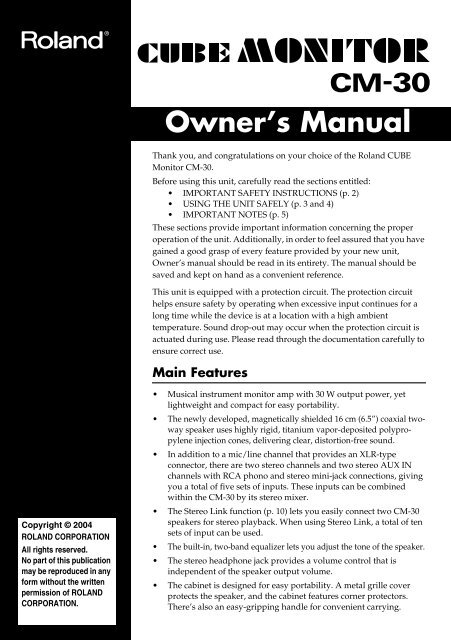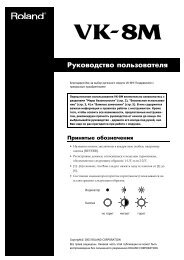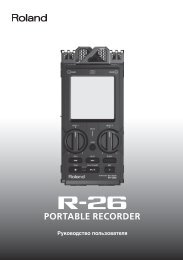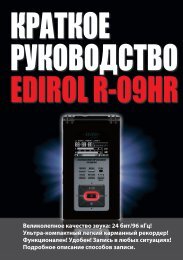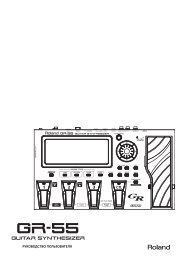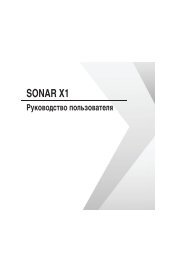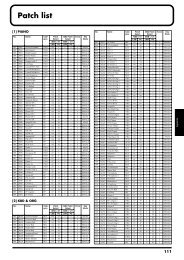Create successful ePaper yourself
Turn your PDF publications into a flip-book with our unique Google optimized e-Paper software.
Owner’s <strong>Manual</strong><br />
Thank you, and congratulations on your choice of the <strong>Roland</strong> CUBE<br />
Monitor <strong>CM</strong>-<strong>30</strong>.<br />
Before using this unit, carefully read the sections entitled:<br />
• IMPORTANT SAFETY INSTRUCTIONS (p. 2)<br />
• USING THE UNIT SAFELY (p. 3 and 4)<br />
• IMPORTANT NOTES (p. 5)<br />
These sections provide important information concerning the proper<br />
operation of the unit. Additionally, in order to feel assured that you have<br />
gained a good grasp of every feature provided by your new unit,<br />
Owner’s manual should be read in its entirety. The manual should be<br />
saved and kept on hand as a convenient reference.<br />
This unit is equipped with a protection circuit. The protection circuit<br />
helps ensure safety by operating when excessive input continues for a<br />
long time while the device is at a location with a high ambient<br />
temperature. Sound drop-out may occur when the protection circuit is<br />
actuated during use. Please read through the documentation carefully to<br />
ensure correct use.<br />
Main Features<br />
Copyright © 2004<br />
ROLAND CORPORATION<br />
All rights reserved.<br />
No part of this publication<br />
may be reproduced in any<br />
form without the written<br />
permission of ROLAND<br />
CORPORATION.<br />
• Musical instrument monitor amp with <strong>30</strong> W output power, yet<br />
lightweight and compact for easy portability.<br />
• The newly developed, magnetically shielded 16 cm (6.5”) coaxial twoway<br />
speaker uses highly rigid, titanium vapor-deposited polypropylene<br />
injection cones, delivering clear, distortion-free sound.<br />
• In addition to a mic/line channel that provides an XLR-type<br />
connector, there are two stereo channels and two stereo AUX IN<br />
channels with RCA phono and stereo mini-jack connections, giving<br />
you a total of five sets of inputs. These inputs can be combined<br />
within the <strong>CM</strong>-<strong>30</strong> by its stereo mixer.<br />
• The Stereo Link function (p. 10) lets you easily connect two <strong>CM</strong>-<strong>30</strong><br />
speakers for stereo playback. When using Stereo Link, a total of ten<br />
sets of input can be used.<br />
• The built-in, two-band equalizer lets you adjust the tone of the speaker.<br />
• The stereo headphone jack provides a volume control that is<br />
independent of the speaker output volume.<br />
• The cabinet is designed for easy portability. A metal grille cover<br />
protects the speaker, and the cabinet features corner protectors.<br />
There’s also an easy-gripping handle for convenient carrying.
WARNING: To reduce the risk of fire or electric shock, do not expose this apparatus to rain or moisture.<br />
CAUTION<br />
RISK OF ELECTRIC SHOCK<br />
DO NOT OPEN<br />
ATTENTION: RISQUE DE CHOC ELECTRIQUE NE PAS OUVRIR<br />
CAUTION: TO REDUCE THE RISK OF ELECTRIC SHOCK,<br />
DO NOT REMOVE COVER (OR BACK).<br />
NO USER-SERVICEABLE PARTS INSIDE.<br />
REFER SERVICING TO QUALIFIED SERVICE PERSONNEL.<br />
The lightning flash with arrowhead symbol, within an<br />
equilateral triangle, is intended to alert the user to the<br />
presence of uninsulated “dangerous voltage” within the<br />
product’s enclosure that may be of sufficient magnitude to<br />
constitute a risk of electric shock to persons.<br />
The exclamation point within an equilateral triangle is<br />
intended to alert the user to the presence of important<br />
operating and maintenance (servicing) instructions in the<br />
literature accompanying the product.<br />
INSTRUCTIONS PERTAINING TO A RISK OF FIRE, ELECTRIC SHOCK, OR INJURY TO PERSONS.<br />
IMPORTANT SAFETY INSTRUCTIONS<br />
SAVE THESE INSTRUCTIONS<br />
WARNING - When using electric products, basic precautions should always be followed, including the following:<br />
1. Read these instructions.<br />
2. Keep these instructions.<br />
3. Heed all warnings.<br />
4. Follow all instructions.<br />
5. Do not use this apparatus near water.<br />
6. Clean only with a dry cloth.<br />
7. Do not block any of the ventilation openings. Install in<br />
accordance with the manufacturers instructions.<br />
8. Do not install near any heat sources such as radiators,<br />
heat registers, stoves, or other apparatus (including<br />
amplifiers) that produce heat.<br />
9. Do not defeat the safety purpose of the polarized or<br />
grounding-type plug. A polarized plug has two blades with<br />
one wider than the other. A grounding type plug has two<br />
blades and a third grounding prong. The wide blade or the<br />
third prong are provided for your safety. If the provided plug<br />
does not fit into your outlet, consult an electrician for<br />
replacement of the obsolete outlet.<br />
10. Protect the power cord from being walked on or pinched<br />
particularly at plugs, convenience receptacles, and the<br />
point where they exit from the apparatus.<br />
11. Only use attachments/accessories specified<br />
by the manufacturer.<br />
13. Unplug this apparatus during lightning storms or when<br />
unused for long periods of time.<br />
14. Refer all servicing to qualified service personnel. Servicing<br />
is required when the apparatus has been damaged in any<br />
way, such as power-supply cord or plug is damaged, liquid<br />
has been spilled or objects have fallen into the apparatus,<br />
the apparatus has been exposed to rain or moisture, does<br />
not operate normally, or has been dropped.<br />
For the U.K.<br />
IMPORTANT: THE WIRES IN THIS MAINS LEAD ARE COLOURED IN ACCORDANCE WITH THE FOLLOWING CODE.<br />
BLUE:<br />
BROWN:<br />
NEUTRAL<br />
LIVE<br />
As the colours of the wires in the mains lead of this apparatus may not correspond with the coloured markings identifying<br />
the terminals in your plug, proceed as follows:<br />
The wire which is coloured BLUE must be connected to the terminal which is marked with the letter N or coloured BLACK.<br />
The wire which is coloured BROWN must be connected to the terminal which is marked with the letter L or coloured RED.<br />
Under no circumstances must either of the above wires be connected to the earth terminal of a three pin plug.
USING THE UNIT SAFELY<br />
Used for instructions intended to alert<br />
the user to the risk of death or severe<br />
injury should the unit be used<br />
improperly.<br />
Used for instructions intended to alert<br />
the user to the risk of injury or material<br />
damage should the unit be used<br />
improperly.<br />
* Material damage refers to damage or<br />
other adverse effects caused with<br />
respect to the home and all its<br />
furnishings, as well to domestic<br />
animals or pets.<br />
The symbol alerts the user to important instructions<br />
or warnings.The specific meaning of the symbol is<br />
determined by the design contained within the<br />
triangle. In the case of the symbol at left, it is used for<br />
general cautions, warnings, or alerts to danger.<br />
The symbol alerts the user to items that must never<br />
be carried out (are forbidden). The specific thing that<br />
must not be done is indicated by the design contained<br />
within the circle. In the case of the symbol at left, it<br />
means that the unit must never be disassembled.<br />
The ● symbol alerts the user to things that must be<br />
carried out. The specific thing that must be done is<br />
indicated by the design contained within the circle. In<br />
the case of the symbol at left, it means that the powercord<br />
plug must be unplugged from the outlet.<br />
001<br />
• Before using this unit, make sure to read the<br />
instructions below, and the Owner’s<br />
<strong>Manual</strong>.<br />
..................................................................................................<br />
002a<br />
• Do not open or perform any internal modifications<br />
on the unit.<br />
..................................................................................................<br />
003<br />
• Do not attempt to repair the unit, or replace<br />
parts within it (except when this manual<br />
provides specific instructions directing you<br />
to do so). Refer all servicing to your retailer,<br />
the nearest <strong>Roland</strong> Service Center, or an<br />
authorized <strong>Roland</strong> distributor, as listed on<br />
the “Information” page.<br />
..................................................................................................<br />
004<br />
• Never use or store the unit in places that<br />
are:<br />
• Subject to temperature extremes (e.g.,<br />
direct sunlight in an enclosed vehicle,<br />
near a heating duct, on top of heat-generating<br />
equipment); or are<br />
• Damp (e.g., baths, washrooms, on wet<br />
floors); or are<br />
• Humid; or are<br />
• Exposed to rain; or are<br />
• Dusty; or are<br />
• Subject to high levels of vibration.<br />
..................................................................................................<br />
008a<br />
• The unit should be connected to a power<br />
supply only of the type described in the<br />
operating instructions, or as marked on the<br />
rear side of unit.<br />
..................................................................................................<br />
008e<br />
• Use only the attached power-supply cord.<br />
Also, the supplied power cord must not be<br />
used with any other device.<br />
..................................................................................................<br />
009<br />
• Do not excessively twist or bend the power<br />
cord, nor place heavy objects on it. Doing so<br />
can damage the cord, producing severed<br />
elements and short circuits. Damaged cords<br />
are fire and shock hazards!<br />
..................................................................................................<br />
010<br />
• This unit, either alone or in combination<br />
with an amplifier and headphones or<br />
speakers, may be capable of producing<br />
sound levels that could cause permanent<br />
hearing loss. Do not operate for a long<br />
period of time at a high volume level, or at a<br />
level that is uncomfortable. If you<br />
experience any hearing loss or ringing in the<br />
ears, you should immediately stop using the<br />
unit, and consult an audiologist.<br />
..................................................................................................<br />
011<br />
• Do not allow any objects (e.g., flammable<br />
material, coins, pins); or liquids of any kind<br />
(water, soft drinks, etc.) to penetrate the<br />
unit.<br />
..................................................................................................<br />
3
012a<br />
• Immediately turn the power off, remove the<br />
power cord from the outlet, and request<br />
servicing by your retailer, the nearest<br />
<strong>Roland</strong> Service Center, or an authorized<br />
<strong>Roland</strong> distributor, as listed on the “Information”<br />
page when:<br />
• The power-supply cord, or the plug has<br />
been damaged; or<br />
• If smoke or unusual odor occurs<br />
• Objects have fallen into, or liquid has<br />
been spilled onto the unit; or<br />
• The unit has been exposed to rain (or<br />
otherwise has become wet); or<br />
• The unit does not appear to operate<br />
normally or exhibits a marked change in<br />
performance.<br />
..................................................................................................<br />
013<br />
• In households with small children, an adult<br />
should provide supervision until the child<br />
is capable of following all the rules essential<br />
for the safe operation of the unit.<br />
..................................................................................................<br />
014<br />
• Protect the unit from strong impact.<br />
(Do not drop it!)<br />
..................................................................................................<br />
015<br />
• Do not force the unit’s power-supply cord<br />
to share an outlet with an unreasonable<br />
number of other devices. Be especially<br />
careful when using extension cords—the<br />
total power used by all devices you have<br />
connected to the extension cord’s outlet<br />
must never exceed the power rating (watts/<br />
amperes) for the extension cord. Excessive<br />
loads can cause the insulation on the cord to<br />
heat up and eventually melt through.<br />
..................................................................................................<br />
016<br />
• Before using the unit in a foreign country,<br />
consult with your retailer, the nearest<br />
<strong>Roland</strong> Service Center, or an authorized<br />
<strong>Roland</strong> distributor, as listed on the “Information”<br />
page.<br />
..................................................................................................<br />
026<br />
• Do not put anything that contains water<br />
(e.g., flower vases) on this unit. Also, avoid<br />
the use of insecticides, perfumes, alcohol,<br />
nail polish, spray cans, etc., near the unit. Swiftly<br />
wipe away any liquid that spills on the unit using a<br />
dry, soft cloth.<br />
..................................................................................................<br />
101a<br />
• The unit should be located so that its<br />
location or position does not interfere with<br />
its proper ventilation.<br />
..................................................................................................<br />
102b<br />
• Always grasp only the plug on the powersupply<br />
cord when plugging into, or<br />
unplugging from, an outlet or this unit.<br />
..................................................................................................<br />
103a<br />
• At regular intervals, you should unplug the<br />
power plug and clean it by using a dry cloth<br />
to wipe all dust and other accumulations<br />
away from its prongs. Also, disconnect the<br />
power plug from the power outlet<br />
whenever the unit is to remain unused for<br />
an extended period of time. Any accumulation<br />
of dust between the power plug and<br />
the power outlet can result in poor<br />
insulation and lead to fire.<br />
..................................................................................................<br />
104<br />
• Try to prevent cords and cables from<br />
becoming entangled. Also, all cords and<br />
cables should be placed so they are out of<br />
the reach of children.<br />
..................................................................................................<br />
106<br />
• Never climb on top of, nor place heavy<br />
objects on the unit.<br />
..................................................................................................<br />
107b<br />
• Never handle the power cord or its plugs<br />
with wet hands when plugging into, or<br />
unplugging from, an outlet or this unit.<br />
..................................................................................................<br />
109a<br />
• Before cleaning the unit, turn off the power<br />
and unplug the power cord from the outlet<br />
(p. 9).<br />
..................................................................................................<br />
110a<br />
• Whenever you suspect the possibility of<br />
lightning in your area, pull the plug on the<br />
power cord out of the outlet.<br />
..................................................................................................<br />
119<br />
• The rear of this unit may become hot, so<br />
take care to avoid burns.<br />
..................................................................................................<br />
4
IMPORTANT NOTES<br />
291b<br />
In addition to the items listed under “IMPORTANT SAFETY INSTRUCTIONS” and “USING THE UNIT SAFELY” on pages 2,<br />
3 and 4, please read and observe the following:<br />
Power Supply<br />
<strong>30</strong>1<br />
• Do not connect this unit to same electrical outlet that<br />
is being used by an electrical appliance that is<br />
controlled by an inverter (such as a refrigerator,<br />
washing machine, microwave oven, or air conditioner),<br />
or that contains a motor. Depending on the<br />
way in which the electrical appliance is used, power<br />
supply noise may cause this unit to malfunction or<br />
may produce audible noise. If it is not practical to<br />
use a separate electrical outlet, connect a power<br />
supply noise filter between this unit and the<br />
electrical outlet.<br />
<strong>30</strong>7<br />
• Before connecting this unit to other devices, turn off<br />
the power to all units. This will help prevent<br />
malfunctions and/or damage to speakers or other<br />
devices.<br />
<strong>30</strong>8<br />
• Although the LED are switched off when the<br />
POWER switch is switched off, this does not mean<br />
that the unit has been completely disconnected from<br />
the source of power. If you need to turn off the<br />
power completely, first turn off the POWER switch,<br />
then unplug the power cord from the power outlet.<br />
For this reason, the outlet into which you choose to<br />
connect the power cord’s plug should be one that is<br />
within easy reach.<br />
Placement<br />
352a<br />
• This device may interfere with radio and television<br />
reception. Do not use this device in the vicinity of<br />
such receivers.<br />
352b<br />
• Noise may be produced if wireless communications<br />
devices, such as cell phones, are operated in the<br />
vicinity of this unit. Such noise could occur when<br />
receiving or initiating a call, or while conversing.<br />
Should you experience such problems, you should<br />
relocate such wireless devices so they are at a<br />
greater distance from this unit, or switch them off.<br />
354b<br />
• Do not expose the unit to direct sunlight, place it<br />
near devices that radiate heat, leave it inside an<br />
enclosed vehicle, or otherwise subject it to temperature<br />
extremes. Also, do not allow lighting devices<br />
that normally are used while their light source is<br />
very close to the unit (such as a piano light), or<br />
powerful spotlights to shine upon the same area of<br />
the unit for extended periods of time. Excessive heat<br />
can deform or discolor the unit.<br />
355b<br />
• When moved from one location to another where<br />
the temperature and/or humidity is very different,<br />
water droplets (condensation) may form inside the<br />
unit. Damage or malfunction may result if you<br />
attempt to use the unit in this condition. Therefore,<br />
before using the unit, you must allow it to stand for<br />
several hours, until the condensation has completely<br />
evaporated.<br />
356<br />
• Do not allow rubber, vinyl, or similar materials to<br />
remain on the unit for long periods of time. Such<br />
objects can discolor or otherwise harmfully affect the<br />
finish.<br />
359<br />
• Do not paste stickers, decals, or the like to this<br />
instrument. Peeling such matter off the instrument<br />
may damage the exterior finish.<br />
Maintenance<br />
401a<br />
• For everyday cleaning wipe the unit with a soft, dry<br />
cloth or one that has been slightly dampened with<br />
water. To remove stubborn dirt, use a cloth impregnated<br />
with a mild, non-abrasive detergent. Afterwards,<br />
be sure to wipe the unit thoroughly with a<br />
soft, dry cloth.<br />
402<br />
• Never use benzine, thinners, alcohol or solvents of<br />
any kind, to avoid the possibility of discoloration<br />
and/or deformation.<br />
Additional Precautions<br />
553<br />
• Use a reasonable amount of care when using the<br />
unit’s buttons, sliders, or other controls; and when<br />
using its jacks and connectors. Rough handling can<br />
lead to malfunctions.<br />
556<br />
• When connecting / disconnecting all cables, grasp<br />
the connector itself—never pull on the cable. This<br />
way you will avoid causing shorts, or damage to the<br />
cable’s internal elements.<br />
557<br />
• A small amount of heat will radiate from the unit<br />
during normal operation.<br />
558a<br />
• To avoid disturbing your neighbors, try to keep the<br />
unit’s volume at reasonable levels. You may prefer<br />
to use headphones, so you do not need to be<br />
concerned about those around you (especially when<br />
it is late at night).<br />
559a<br />
• When you need to transport the unit, package it in<br />
the box (including padding) that it came in, if<br />
possible. Otherwise, you will need to use equivalent<br />
packaging materials.<br />
562<br />
• Use a cable from <strong>Roland</strong> to make the connection. If<br />
using some other make of connection cable, please<br />
note the following precautions.<br />
- Some connection cables contain resistors. Do not<br />
use cables that incorporate resistors for<br />
connecting to this unit. The use of such cables can<br />
cause the sound level to be extremely low, or<br />
impossible to hear. For information on cable<br />
specifications, contact the manufacturer of the<br />
cable.<br />
5
Panel Descriptions<br />
■ Control Panel<br />
fig.01<br />
6<br />
1 2 3 4 5 7<br />
■ Jack Panel<br />
fig.01<br />
2<br />
1<br />
9<br />
8<br />
10<br />
6
Panel Descriptions<br />
1. CH 1 knob / CH 1 Input Jacks<br />
In addition to a 1/4” phone jack, this channel is<br />
equipped with a balanced XLR connector, useful<br />
for connecting microphones.<br />
This accepts input levels ranging from mic input<br />
(-50 dBu) to line level from sound modules and<br />
other equipment (-20 dBu).<br />
* The pin assignment for the XLR type connectors is as<br />
shown below. Before making any connections, make sure<br />
that this pin assignment is compatible with that of all<br />
your other devices.<br />
fig.04<br />
2. CH 2 and CH 3 knobs / CH 2 and CH<br />
3 Input Jacks<br />
Use these for connecting keyboards, sound<br />
modules, and other devices.<br />
You can make stereo connections to these inputs.<br />
If you connect only the L jack, the input will be<br />
mono.<br />
If you’re using stereo connections, you can listen<br />
in stereo through headphones or when using a<br />
pair of stereo-linked <strong>CM</strong>-<strong>30</strong> speakers.<br />
They accept line level input (-20 dBu).<br />
3. STEREO PHONES<br />
The headphones allow you to listen in stereo.<br />
LEVEL Knob<br />
This knob adjusts the headphones volume.<br />
PHONES Jack<br />
This is for connecting headphones.<br />
* Before plugging in or unplugging headphones, be sure to<br />
place the LEVEL knob at 0.<br />
4. EQUALIZER<br />
LOW Knob<br />
This adjusts the level of the bass range.<br />
HIGH Knob<br />
This adjusts the level of the treble range.<br />
5. MASTER Knob<br />
This adjusts the total volume level of the unit’s<br />
internal speaker.<br />
6. Power Indicator<br />
This indicator illuminates when the power is on.<br />
7. POWER Switch<br />
This switches the power on and off.<br />
* Always be sure to lower the MASTER knob on the <strong>CM</strong>-<br />
<strong>30</strong> to 0 whenever turning the power on or off.<br />
* This unit is equipped with a protection circuit. A brief<br />
interval (a few seconds) after power up is required before<br />
the unit will operate normally.<br />
Slight pop noise may come from the speakers when the<br />
power is switched on, but this does not indicate a<br />
problem.<br />
* Refer to p. 9 for the order in which to turn the power to<br />
connected devices on and off.<br />
8. AUX IN 1, 2 Jacks<br />
AUX IN 1 are RCA phono type input jacks. AUX<br />
IN 2 is stereo miniature phone type input jack.<br />
You use these to connect equipment such as CD<br />
and MD players, and have them sound along<br />
with the equipment connected to CH 1 through<br />
CH 3.<br />
Both AUX IN 1 and 2 accept level input of -10<br />
dBu.<br />
* To adjust the volume level of equipment connected to the<br />
AUX IN jacks, use the controls on such equipment.<br />
9. STEREO LINK<br />
Stereo playback is enabled simply by connecting<br />
two <strong>CM</strong>-<strong>30</strong> units with a single or double audio<br />
cables (phone type).<br />
* For details on the Stereo Link function, refer to “Using<br />
Two <strong>CM</strong>-<strong>30</strong> Speakers for Stereo Playback (Stereo Link)”<br />
(p. 10).<br />
They provide -10 dBu line level output, and<br />
accept level input of -10 dBu.<br />
10. AC IN Jack<br />
Connect the included power cord to this jack.<br />
* Use only the power cord included with the <strong>CM</strong>-<strong>30</strong>.<br />
7
Making the Connections<br />
Refer to the figure shown below to connect the <strong>CM</strong>-<strong>30</strong> and the other equipment.<br />
Recorder<br />
Keyboard<br />
Control Panel<br />
OUTPUT<br />
OUTPUT<br />
Mic<br />
Jack Panel<br />
Stereo<br />
Headphones<br />
CD Player<br />
Stereo Link (p. 10)<br />
MD Player<br />
Here is an example of a setup that makes full use<br />
of the <strong>CM</strong>-<strong>30</strong>’s mixer and monitor functions.<br />
A mic is input to CH 1, which accepts mic level<br />
input. Connect a keyboard, recorder, or other<br />
sound-generating devices to the CH 2 and CH 3<br />
inputs.<br />
* To prevent malfunction and/or damage to speakers or<br />
other devices, always turn down the volume, and turn off<br />
the power on all devices before making any connections.<br />
Set all of the <strong>CM</strong>-<strong>30</strong>’s channel volume knobs as well as<br />
the MASTER knob to zero.<br />
* Howling could be produced depending on the location of<br />
microphones relative to speakers. This can be remedied<br />
by:<br />
1. Changing the orientation of the microphone.<br />
2. Relocating microphone at a greater distance from<br />
speakers.<br />
3. Lowering volume levels.<br />
* When connection cables with resistors are used, the<br />
volume level of equipment connected to the inputs (CH 1<br />
through CH 3, AUX IN 1 and 2) may be low.<br />
If this happens, use connection cables that do not contain<br />
resistors, such as those from the <strong>Roland</strong> PCS series.<br />
8
Making the Connections<br />
Switching the Power On<br />
and Off<br />
Once the connections have been completed, turn<br />
on power to your various devices in the order<br />
specified. By turning on devices in the wrong<br />
order, you risk causing malfunction and/or<br />
damage to speakers and other devices.<br />
1. Make sure that all volume controls on the<br />
<strong>CM</strong>-<strong>30</strong> and connected devices are set to 0.<br />
About the Volume-level<br />
Settings<br />
In order to get optimum sound from the <strong>CM</strong>-<strong>30</strong><br />
when performing, set the volume as described<br />
below.<br />
1. Operate the CH 1 through CH 3 volume<br />
knobs to adjust the volume level for CH 1<br />
through CH 3.<br />
fig.05<br />
2. Turn on all the devices connected to the <strong>CM</strong>-<br />
<strong>30</strong>’s input jacks (CH 1 through CH 3, AUX<br />
IN 1 and 2).<br />
3. Turn on the <strong>CM</strong>-<strong>30</strong>.<br />
4. Adjust the volume levels for the devices.<br />
5. Before switching off the power, lower the<br />
volume on each of the devices in your<br />
system and then TURN OFF the devices in<br />
the reverse order to which they were<br />
switched on.<br />
* This unit is equipped with a protection circuit. A brief<br />
interval (a few seconds) after power up is required before<br />
the unit will operate normally. For protection from<br />
sudden big sound, always make sure to have the volume<br />
level turned down before switching on power.<br />
* Even with the volume all the way down, you may still<br />
hear some sound when the power is switched on, but this<br />
is normal, and does not indicate a malfunction.<br />
Adjust the volume balance for CH 1 through<br />
CH 3 at this time.<br />
* To adjust the volume levels of equipment connected to the<br />
AUX IN 1 and 2 jacks, use the controls on such<br />
equipment.<br />
2. Adjust the LOW and HIGH knobs to obtain<br />
the tone you want.<br />
3. Use the MASTER knob to adjust the overall<br />
volume level.<br />
fig.06<br />
* If the sound is distorted, lower the CH 1 through CH 3<br />
volume knobs, MASTER knob and/or the volume knobs<br />
for devices connected to the input jacks (CH 1 through<br />
CH 3, AUX IN 1 and 2).<br />
9
Making the Connections<br />
Using Two <strong>CM</strong>-<strong>30</strong> Speakers for Stereo Playback (Stereo Link)<br />
Stereo playback is enabled simply by connecting two <strong>CM</strong>-<strong>30</strong> units with a single or double audio cables<br />
(phone type). This function is called “Stereo Link.”<br />
Since the <strong>CM</strong>-<strong>30</strong>’s mixer section operates in stereo, the L or R channel signal can be output from a<br />
STEREO LINK OUT jack. This means you can enjoy stereo playback by making connections as follows.<br />
● Basic (up to five inputs) stereo playback (Connection example 1)<br />
● Stereo playback (up to ten inputs) using the mixers of both <strong>CM</strong>-<strong>30</strong> units (Connection example 2)<br />
Example 1<br />
You can connect up to five input sources.<br />
fig.08<br />
CH 1–3<br />
AUX IN<br />
1, 2<br />
Example 2<br />
You can connect up to ten input sources.<br />
fig.09<br />
CH 1–3<br />
AUX IN<br />
1, 2 CH 1–3<br />
AUX IN<br />
1, 2<br />
<strong>CM</strong>-<strong>30</strong><br />
L<br />
STEREO LINK<br />
OUT R<br />
<strong>CM</strong>-<strong>30</strong><br />
R<br />
STEREO LINK<br />
IN<br />
<strong>CM</strong>-<strong>30</strong><br />
L<br />
STEREO LINK<br />
IN<br />
STEREO LINK<br />
OUT R<br />
STEREO<br />
LINK IN<br />
<strong>CM</strong>-<strong>30</strong><br />
R<br />
STEREO LINK<br />
OUT L<br />
Operation<br />
1. Connect the devices to the L <strong>CM</strong>-<strong>30</strong>.<br />
2. Connect the STEREO LINK OUT R jack on<br />
the L <strong>CM</strong>-<strong>30</strong> and the STEREO LINK IN jack<br />
on the R <strong>CM</strong>-<strong>30</strong>.<br />
3. Turn on both L and R <strong>CM</strong>-<strong>30</strong>.<br />
4. Adjust the volume levels on all devices.<br />
5. Adjust the R and L <strong>CM</strong>-<strong>30</strong> volume levels<br />
separately using their MASTER knobs.<br />
If you want to connect input sources to the R <strong>CM</strong>-<strong>30</strong><br />
As described in step 1 of example 1, connect the R<br />
side’s STEREO LINK OUT L jack to the L side’s<br />
STEREO LINK IN jack.<br />
Operation<br />
1. Connect the devices to the L and R <strong>CM</strong>-<strong>30</strong>.<br />
2. Connect the STEREO LINK OUT R jack on<br />
the L <strong>CM</strong>-<strong>30</strong> and the STEREO LINK IN jack<br />
on the R <strong>CM</strong>-<strong>30</strong>.<br />
3. Connect the STEREO LINK OUT L jack on<br />
the R <strong>CM</strong>-<strong>30</strong> and the STEREO LINK IN jack<br />
on the L <strong>CM</strong>-<strong>30</strong>.<br />
4. Turn on both L and R <strong>CM</strong>-<strong>30</strong>.<br />
5. Adjust the volume levels on all devices.<br />
6. Adjust the R and L <strong>CM</strong>-<strong>30</strong> volume levels<br />
separately using their MASTER knobs.<br />
■ About the Volume and Tone Settings<br />
Adjust the R and L volume levels separately using their MASTER knobs.<br />
You can adjust the equalizer (LOW and HIGH knobs) independently for the L and R sides.<br />
Basically, they should be set to the same positions, but you can adjust each one as necessary to suit the<br />
needs of a particular setup.<br />
* The STEREO PHONES jack will provide stereo playback of only the sources connected to the local speaker (L or R).<br />
10
Using a Microphone Stand<br />
By using a mic stand, you can mount the <strong>CM</strong>-<strong>30</strong><br />
at the optimal height for use as a monitor speaker<br />
or simple PA device.<br />
Requirements when using a mic stand<br />
●<br />
As shown in the diagram below, the mic<br />
stand’s tripod must be extended to its<br />
maximum width (at least 63 cm/25 inches)<br />
and the height must be less than 110 cm<br />
(including the <strong>CM</strong>-<strong>30</strong>).<br />
Mounting the <strong>CM</strong>-<strong>30</strong> to a<br />
mic stand<br />
Always have at least one other person assist you<br />
when mounting the <strong>CM</strong>-<strong>30</strong> on a mic stand, or<br />
when adjusting the height of the stand while the<br />
<strong>CM</strong>-<strong>30</strong> remains mounted on it.<br />
1. As shown in the diagram, place the <strong>CM</strong>-<strong>30</strong><br />
upside down and rotate the mic stand to screw<br />
it firmly into the <strong>CM</strong>-<strong>30</strong>’s mic stand holder.<br />
* When turning the unit upside-down, get a bunch of<br />
newspapers or magazines, and place them under the four<br />
corners or at both ends to prevent damage to the buttons<br />
and controls. Also, you should try to orient the unit so no<br />
buttons or controls get damaged.<br />
110 cm (43-5/16”)<br />
or less<br />
●<br />
●<br />
●<br />
●<br />
63 cm (24-13/16”) or more<br />
Using a mic stand that does not meet the<br />
specifications above may result in damage to<br />
equipment or injury due to the stand tipping<br />
over.<br />
When using <strong>CM</strong>-<strong>30</strong> with a mic stand, the<br />
mic stand must be carefully placed so it is<br />
level and sure to remain stable.<br />
Cables connected to <strong>CM</strong>-<strong>30</strong> should be given<br />
enough slack to prevent accidents that might<br />
result from someone tripping over them.<br />
To prevent accidents due to falls, do not<br />
place any object on the <strong>CM</strong>-<strong>30</strong> when it’s<br />
mounted on a mic stand.<br />
2. Open the tripod so it’s at full spread.<br />
If the tripod is not fully opened, the stand<br />
will be unstable.<br />
3. Grasp the <strong>CM</strong>-<strong>30</strong> and mic stand, and place<br />
them upright on the floor.<br />
4. Adjust the height of the mic stand as desired,<br />
but do not allow the height (including the<br />
<strong>CM</strong>-<strong>30</strong>) to exceed 110 cm (approx. 43 inches).<br />
5. Firmly tighten the hardware of the mic stand so<br />
that the <strong>CM</strong>-<strong>30</strong> does not wobble to left or right.<br />
* Be careful not to pinch your fingers while performing<br />
these steps.<br />
11
Appendices<br />
Block Diagram<br />
fig.13<br />
CH 1<br />
XLR<br />
L<br />
R<br />
CH 1<br />
PHONE<br />
PHONES<br />
(STEREO)<br />
VOLUME<br />
CH 2<br />
L (MONO)<br />
CH 2<br />
R<br />
VOLUME<br />
LINK OUT L<br />
CH 3<br />
L (MONO)<br />
VOLUME<br />
LINK OUT R<br />
CH 3<br />
R<br />
VOLUME<br />
VOLUME<br />
AUX IN 1<br />
L/R<br />
AUX IN 2<br />
LOW<br />
HIGH<br />
LINK IN<br />
EQUALIZER<br />
SPEAKER<br />
POWER AMP<br />
12
Appendices<br />
Main Specifications<br />
● Rated Power Output<br />
<strong>30</strong> W<br />
● Nominal Input Level (1 kHz)<br />
Channel 1 (MIC/LINE): -50 – -20 dBu<br />
Channel 2, 3 (LINE): -20 dBu<br />
AUX IN 1, 2:<br />
-10 dBu<br />
STEREO LINK IN: -10 dBu<br />
● Nominal Output Level (1 kHz)<br />
STEREO LINK OUT L/R: -10 dBu<br />
* 0 dBu = 0.775 Vrms<br />
● Speakers<br />
16 cm (6.5 inches) + Tweeter (Coaxial 2-way)<br />
● Controls<br />
CH 1 (MIC/LINE), Volume knob<br />
CH 2, 3 (LINE), Volume knobs<br />
STEREO PHONES LEVEL knob<br />
EQUALIZER: LOW knob, HIGH knob<br />
MASTER Knob<br />
POWER Switch<br />
● Indicator<br />
POWER<br />
● Connectors<br />
CH 1 INPUT jacks (XLR type, 1/4” phone type)<br />
CH 2 and 3 INPUT L (MONO) jacks<br />
(1/4” phone type)<br />
CH 2 and 3 INPUT R jacks (1/4” phone type)<br />
AUX IN 1 L, R jacks (RCA phono type)<br />
AUX IN 2 jack (Stereo miniature phone type)<br />
STEREO LINK OUT L, R jacks (1/4” phone type)<br />
STEREO LINK IN jack (1/4” phone type)<br />
STEREO PHONES jack (Stereo 1/4” phone type)<br />
● Power Supply<br />
AC 117 V, AC 2<strong>30</strong> V, AC 240 V<br />
● Power Consumption<br />
32 W<br />
● Dimensions<br />
214 (W) x 238 (D) x 275 (H) mm<br />
8-7/16 (W) x 9-3/8 (D) x 10-7/8 (H) inches<br />
● Weight<br />
5.6 kg / 12 lbs 6 oz<br />
● Accessory<br />
Owner’s <strong>Manual</strong>, Power cord<br />
* In the interest of product improvement, the specifications<br />
and/or appearance of this unit are subject to change<br />
without prior notice.<br />
13
14<br />
MEMO
MEMO<br />
15
For EU Countries<br />
This product complies with the requirements of European<br />
Directives EMC 89/336/EEC and LVD 73/23/EEC.<br />
SD000523<br />
1GT


